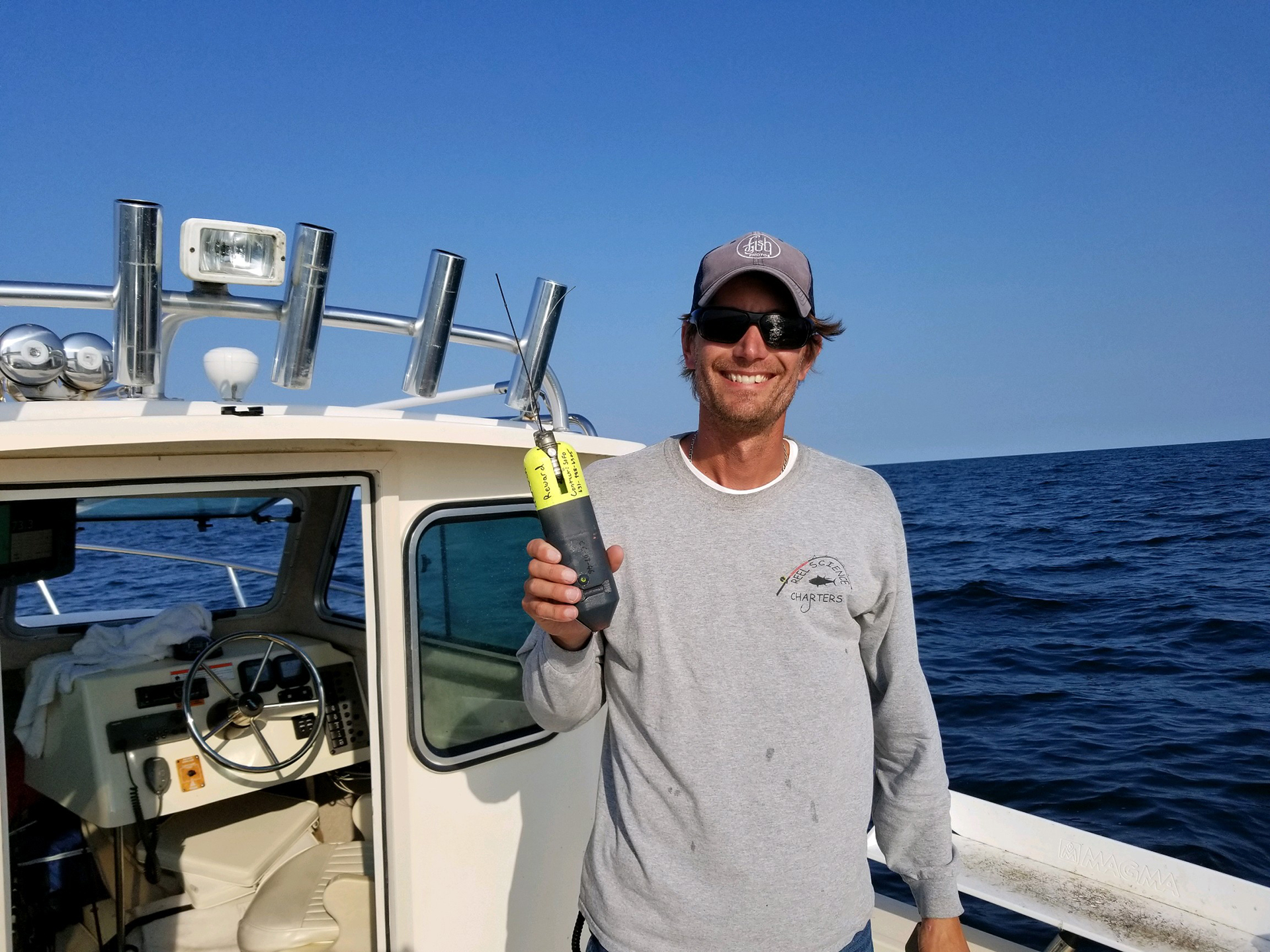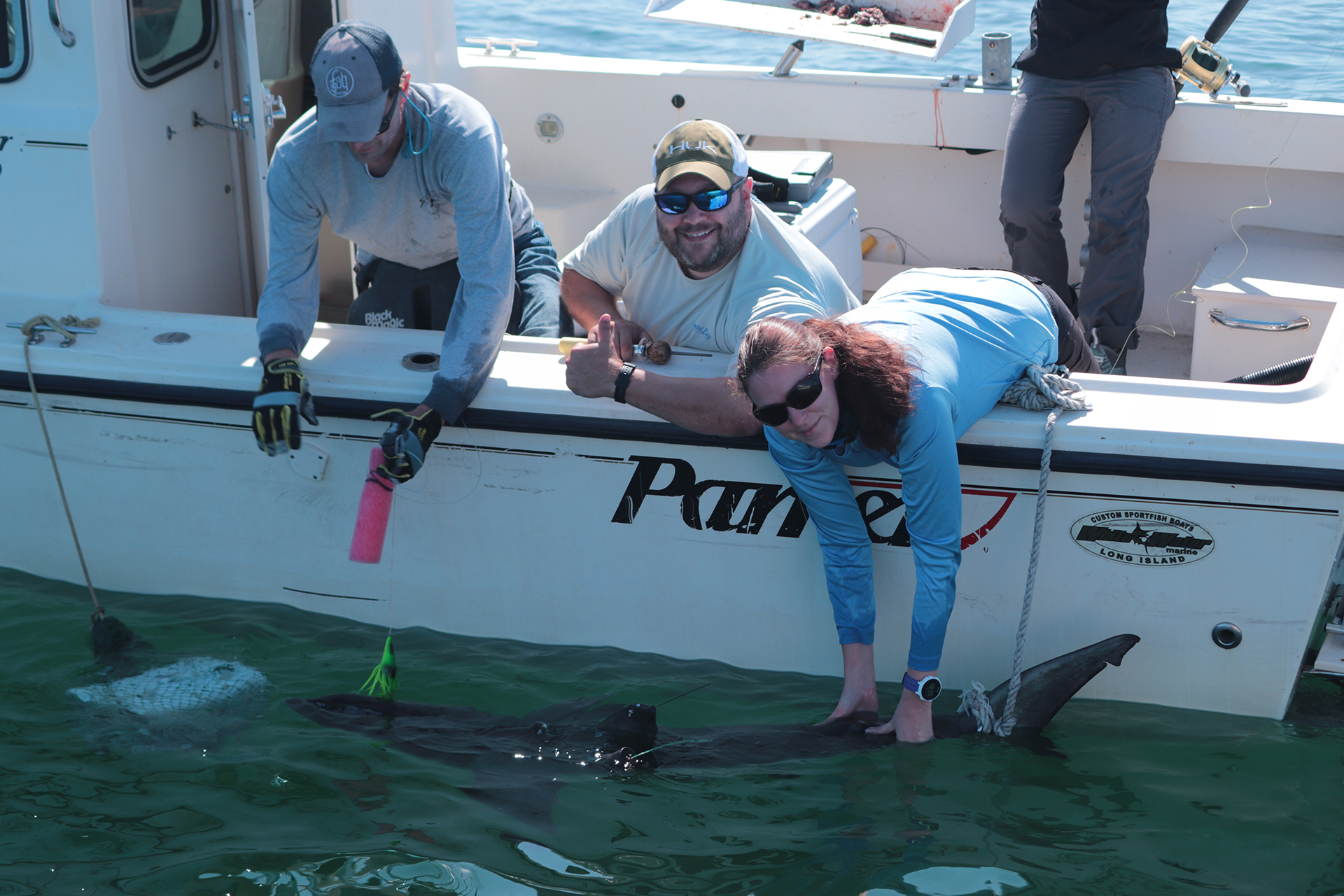Understanding Long Island’s Sharks


Greg Metzger received a ping last week that set off a chain of events.
The Southampton High School marine biology teacher, who had mounted a 28-day pop-off tracking tag on a thresher shark last month, collected GPS data that told him the device had floated to the surface. Seeing it was drifting toward the shores of New Jersey, he made phone calls and got media attention in the surrounding area to find a way to retrieve the tag, and the data along with it.
Metzger’s research, a sort of hobby of his, helps him understand how sharks utilize the water surrounding Long Island. While the work began in 2015 with juvenile great white sharks, also called young-of-the-year white sharks, after tagging his 30th in mid-August amid his field season, he was able to move on to tagging thresher sharks, and he continues to expand his studies.
Because the pop-off tag records the temperature and depth of the water the sharks swim in every five seconds across the length of time it’s attached, repossessing the device is very important. When it floats to the surface, it transmits data collected every five minutes, readings that aren’t as specific as what’s accessible with the device in-hand.
“It’s not often you get to actually retrieve the device, with many who find them not knowing what they are, or commercial fishermen crushing them up and throwing them away,” Metzger said. “That’s why being able to get this tag is super-duper exciting. It’s high-resolution data. That’s why it’s worth it for me to throw my 18-month-old daughter in the car and listen to her scream all the way to New Jersey and back.”
Metzger’s tag is one of seven pop-off tags affixed to sharks this summer — the only on a thresher — with most mounted to the juvenile great whites he’s been researching. There were also two CATS-cam (customized animal tracking solutions) tags sent out — $12,000 pieces of equipment that record a shark’s movement in three dimensions — that measure the angle at which the sharks are changing direction, and the speed at which they are doing so. One is also outfitted with a high-definition camera to get a view from the back of the shark.
“We’re trying to figure out why they utilize Long Island waters,” Metzger said. “And how they do so when they’re here.”
The First Tag
The teacher began discussing this idea back in 2014 with his three college friends — Dr. Tobey Curtis, with the National Marine Fisheries Service, Frank Quevedo, executive director of the South Fork Natural History Museum and Nature Center, and Chris Paparo, who is a lecturer, writer, and photographer behind Fish Guy Photos — who graduated with marine biology degrees from Long Island University’s Southampton campus in the late 1990s. He had been catching and releasing sharks when fishing recreationally, and thought of all the data constantly swimming away. So, in 2015, he applied for permits to be able to catch and tag the sharks.
The group’s first field season led to the tagging of the first-ever young-of-the-year in the Atlantic Ocean. It also led to Ocearch, a data-centric organization built to help scientists collect previously unattainable data in the ocean, reaching out to the group, known then as the Long Island Shark Collaboration, to provide resources and educate Metzger on how to consistently target, catch, and tag more sharks. They partnered in 2016 and 2017, and tagged a total of 20 juvenile great white sharks.
“That was super significant so that we could continue our research in Ocearch’s absence,” Metzger said.
There has been anecdotal evidence for some time that Long Island could be a nursery for white sharks, and the data collected helps scientists understand things like the warmest and coldest waters they will swim in, how deep or shallow those waters are, if they like to swim further offshore, what swimming patterns keep them at ideal temperatures, how they maintain that, and whether it changes from day to night. Catching and tagging sharks, about a 12-minute process, puts some stress on the fish, so the data could also show how they recover and how long it takes them. This could help for commercial and recreational fishermen that accidentally reel in a shark.
This aspect was important to Walter Zublionis, who deals with data as a software consultant for Information Builders, and has known Metzger for 12 years. He became heavily involved in this past field season, which began August 11. While it’s said you need a bigger boat, tongue-in-cheek from the “Jaws” movie franchise, it’s actually more boats Metzger needs for his operation. So Zublionis bought a boat this year, and a stronger rod to help.

Can LI Support A Nursery?
Because of Quevedo’s involvement, SOFO brought in the research under the nonprofit’s umbrella, helping the group apply for grants, and allowing for tax write-off donations, all money that is mainly used for purchasing the tags. The museum created an exhibit to showcase the work, and offers guest lectures to inform the public. SOFO’s involvement also made it possible for one paid intern a field season who acts as Metzger’s field mate. That’s what hooked Zublionis, who used to lead a Port Jefferson Station Cub Scout pack when his sons were younger.
“The kids are involved in every aspect of what we do — bringing the fish in, tagging them. We actually teach them all about fishing, from how we go about doing this, to how weather plays a part, to why we do this,” Zublionis said. “To see them light up when they see a shark for the very first time . . . that really pulled me in. At that moment, there was no turning back. I told Greg, ‘I’m all in.’ Whatever I could do, as much time as I could devote to this, I’m willing.”
As someone who originally grew up wanting to be a marine biologist, who breeds fish in his basement, the project became another way for Zublionis to be able to live his dream as one of the few involved without a doctorate or masters in the field.
Metzger said the work has allowed him to partner with other scientists along the way, sending samples of blood, bacteria on teeth, and parasites to further their work. Once the other pop-off tags are collected, the data will also be used for studies involving
climate modeling scientists.
“We are hoping once we get that data we will be able to start answering questions of how the shark nursery on Long Island would be affected based on projected climate changes,” Metzger said. “We know from our data that these white sharks prefer a temperature range, and if projected increased ocean temperatures continue, how long before Long Island is too warm to support the nursery for white sharks? And where would the nursery move to?”
The group’s work only goes as far as its funding, and the teacher is hoping that as years progress, and with more money, different species of sharks like sandbar, dusky, and hammerhead can be tagged.
“It’s a very humbling position we are in, to have identified the only nursery for white sharks in the entire Atlantic Ocean,” Metzger said. “And that is 100 percent because of the work we’ve gotten to do over the last five years. Our work really is pioneering, and it’s pretty awesome to think of how the data we collect will impact future Atlantic scientists as more questions are asked. It’s amazing to think we are literally setting the foundation for an entire multiple lifetimes’ worth of opportunities moving forward.”
desiree@indyeastend.com



